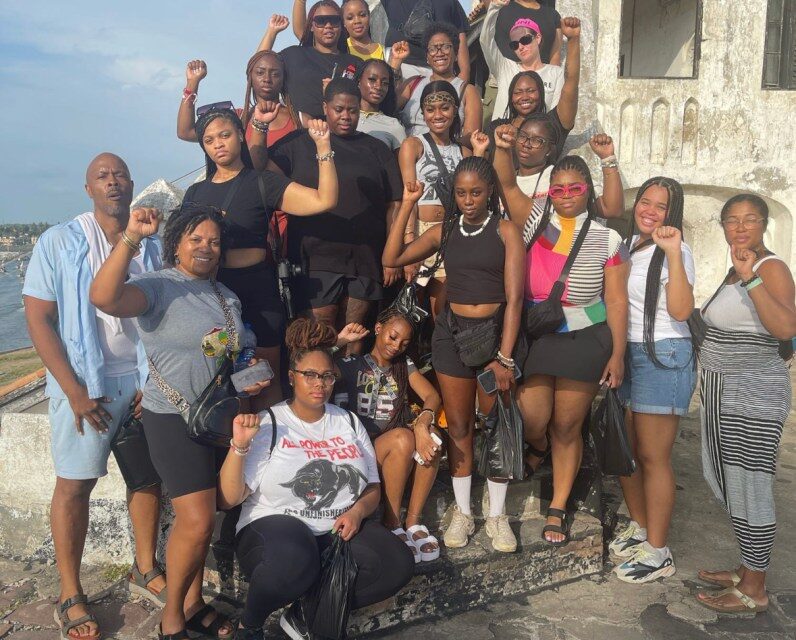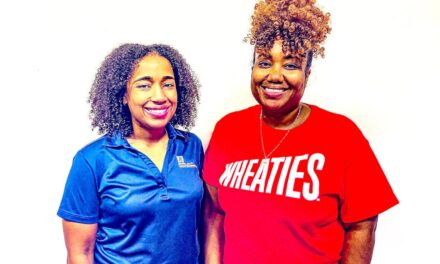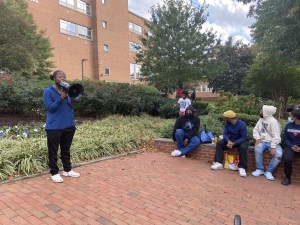By Ariyana Griffin,
Special to the AFRO
Today, we woke up bright and early to head to Cape Coast. This central region of Ghana is full of rich history and incredible attractions. Our faculty leaders notified us today would be an emotion- heavy day due to us visiting Elmina Castle, one of about 40 slave dungeons in the country.
We started by visiting a rainforest at Kakum National Park, where we could partake in a canopy walk over 30 meters from the ground. Not afraid of heights, I instantly was down to participate; however, the hike quickly humbled me. Although the activity was slightly physically demanding it was no match for the beautiful sounds of the forest.
We brushed through the area to make it to the first canopy. Safe to say, I was not as prepared as some of my classmates. With seven in total, I did the first two before deciding the canopies won. Standing in the middle of a canopy, I looked and instantly realized that this was not a National Geographic photo, I was in the middle of a rainforest in Africa. Standing still, I listened to the sounds of nature that I have never experienced and became entranced by the breathtaking views.
Tired, thrilled and feeling accomplished, we began to walk back down the trail towards the bus. Along the route were some vendors selling cacao, a fruit used to create one of the greatest creations known to man: Chocolate. Unfamiliar with the fruit, I was taught how to eat it, which consisted of not eating or chewing the seed. You simply suck the fruit off and dispose of the seed, similar to a pomegranate. I had no idea chocolate came from such a sweet fruit, but it makes sense. Once I reached the bottom of the trail, I stopped by the market and grabbed a few more souvenirs before heading to our next stop.
Both anticipation and dread filled me enroute to the next destination. Upon arrival, we were met by the cool breeze sent to us by the ocean. We gathered together, ready to enter the large white building used during the transatlantic slave trade. Nothing can truly prepare you for the pure horror and atrocity that stood behind the entrance of Elmina Castle.
Built by the Portuguese in 1482, it is said to be the “first trading post built on the Gulf of Guinea and the oldest European building in existence south of the Sahara.” Throughout its operation for more than three centuries thousands of women, men and children were forced to be enslaved.
Silence took over as we walked in, looking around as the reality of where we were starting to settle in. My eyes glanced around the dungeon as my heartbeat increased. I read a sign for female slave dungeons, a sign with a large skull and crossbones making an X underneath, male slave dungeon, and others that made my heart sink. A church was built on top of the dungeons where people would give praise while others suffered and died below. My heart felt heavy and my eyes welled up with tears as I thought about the fate of all who entered Elmina Castle. No textbook could ever describe the feelings I felt walking through the dungeons. My mind could never even fathom the actual torture that our ancestors were forced to endure for centuries.
Our tour guide walked us through the steps of the enslaved people who once stood where we were. We learned about the tactics used to punish, scare, emasculate and harm those who were enslaved.
The rooms were dark, poorly ventilated, warm, stuffy and all around crept with fright. I took a moment and thought, if it feels this way with just 20 or so of us for a few minutes, imagine how it felt with 400-plus humans for months. My mind, struggling to wrap my head around the concept, realized just how important it is for us to learn our history and what a privilege it was to be learning it where I was standing.
Led into the cell I mentioned earlier with the skull, we all became alarmed when our guide closed the door, replicating a small dose of what it felt like to be trapped inside. The door had tiny squares cut into it, a sorry air source. Where we stood, no one ever made it out alive. There were scratches on the wall engraved from people’s nails as a result of the agony that they were going through. The only time the door was opened was to remove someone who had passed away; no water or food was given.
We trailed through the dungeon until we reached the door of no return. It is a small, narrow opening in the wall where the water used to meet the building. This is where they would be transferred to boats or ships during the transatlantic slave trade.
Water, food and flowers left by visitors filled the room.
As I type this, I do not have words to explain my emotions honestly. We stood freely in the place where our ancestors were captives. I believe my colleagues share a similar sentiment, few able to gather and articulate their thoughts. “As a history major, I feel I am supposed to push the agenda of teaching people more about Black history. It was a bad experience, but it was a good experience at the same time,” said Camille James, a senior history major at MSU.
Our guide left us with a powerful quote that I will carry with me, “Until the lions have their history, the hunters will always be the hero.”
I knew it was important to learn our history before, but this cemented a seed in me to do my duty to learn more, read more and research more. I feel obligated, especially having the privilege and resources to do so.
We headed back to our hotel with our hearts and minds heavy as we discussed some of what we were feeling with each other before preparing for our flight to Tamale tomorrow.
Ariyana Griffin is an AFRO Intern from Morgan State University.
The post Ariyana Abroad: A message from Cape Coast appeared first on AFRO American Newspapers .










